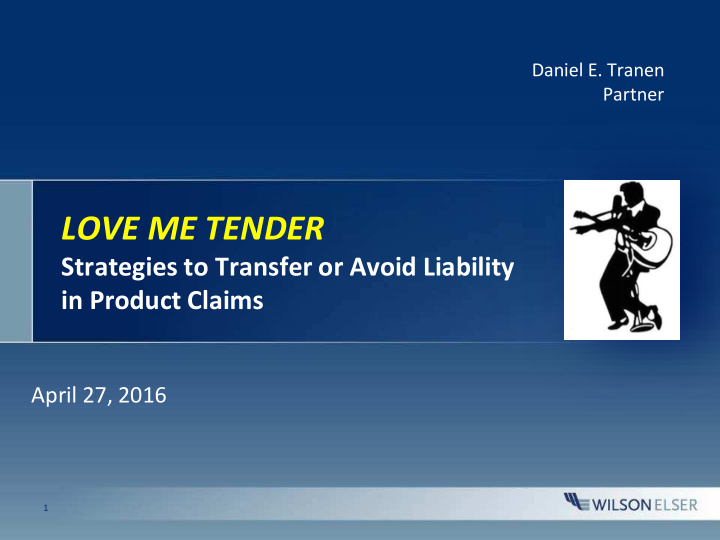



Daniel E. Tranen Partner LOVE ME TENDER Strategies to Transfer or Avoid Liability in Product Claims April 27, 2016 1
The Highlights of this Webinar • Why tender in a product liability claim? • How, when and to whom to make a tender? • Strategies for effective tenders (including insurance). • Ways to respond to, delay and/or defeat tenders. • A checklist for being prepared for this process. 2
What is a Tender? 3
Why Tender in a Products Claim? • Shift focus to responsible party. • Contractual/statutory/common law rights to do so. • Share/shift risk to other insurers. • Consolidate defense. • Reasons not to tender? 4
Bases For Tender Requests What to look for: • Statutory/common law risk shifting. • Contractual duties – most common. • Via responsible party’s policy of insurance. The key is to make sure to identify each and every tender opportunity and employ them all 5
Tender: How, When and To Whom? • Make the request in writing explaining the basis for the tender. • Make tender as soon as possible with thought to mounting expenses, but with strategic considerations for timing of tender. • Focus on parties “upstream” and review all contracts. • Look for insurance. 6
Language of the Tender • “The agreement provided…” • Request to “indemnify, defend and hold harmless”. • “From any and all liabilities, claims, damages and/or expenses”. • Explain why the tender applies in this case. • Issue deadlines and be prepared to force the issue! 7
Typical Product Liability Tenders: Tender From Distributors to Manufacturers • Generally, manufacturers have a greater exposure. • Pass-through exposure? • State law analysis: At least twenty-five states have enacted some form of legislative protection to shield non-manufacturing sellers from liability. 8
Tender from Product Manufacturers to Component Part Manufacturers • Where did the defect come from? • Quality agreements. • Are product manufacturers “vendors” of products sold by component part manufacturers? 9
Case Study: Distributor Tender to Manufacturer 10
Insurance and Tenders • Many insurance policies cover a policyholder’s “insured contracts” under which the policy holder has an obligation to indemnify. • Other routes to coverage… – Through vendor coverage. – Definition of “who is an insured?” • In general, an insured indemnity obligation makes an indemnitor’s insurance primary. 11
Insurance Tender Strategies • Tender to both indemnitor and its insurer. • Tendering to indemnitor does not trigger coverage under indemnitor’s policy. • Insurers take duty to defend more seriously. • Leverage “additional insured” status. • If necessary, force key insurer to file interpleader. 12
Case Study: The Insurance Tender 13
Other Insurance Strategies • Make sure all indemnity agreements are backstopped by insurance. • Request a copy of the policy (now and later). • If no insurance, review business contract for insurance language – (you might have a separate claim for breach of contract on top of indemnity claim – which may offer benefits). 14
Strategies to Respond to Tenders • Is the indemnity provision enforceable? • What is the scope of the indemnity provision? • Is the indemnity promise backstopped by insurance? • Gather all applicable insurance policies and compare “other insurance” clauses. • Are there benefits to delay? 15
Case Study: A Tender Response 16
A Checklist to be Prepared for Future Tenders • Audit your relationships up the supply chain. • Use Quality Agreements (and make certain others do so up the supply chain). • Ensure that indemnity obligations are backstopped by insurance. • Understand the insurance that backstops these agreements. • Audit your relationships down the distribution chain and make sure your insurance protects you from tenders that may come your way. 17
Q&A Daniel E. Tranen, Esq. Partner Wilson Elser Moskowitz Edelman & Dicker LLP Edwardsville, IL/St. Louis, MO daniel.tranen@wilsonelser.com 18
Recommend
More recommend